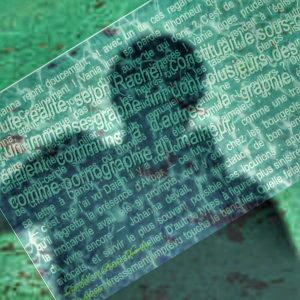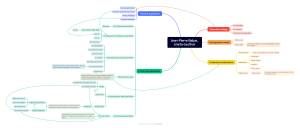 For the last several months the lab has been working with Erika Fülöp, from the University of Toulouse and an Affiliate Faculty member of ELL, to build an exhibition to honor the art of French pioneer, Jean-Pierre Balpe. The exhibition opened yesterday simultaneously at the University of Paris 8 and The NEXT.
For the last several months the lab has been working with Erika Fülöp, from the University of Toulouse and an Affiliate Faculty member of ELL, to build an exhibition to honor the art of French pioneer, Jean-Pierre Balpe. The exhibition opened yesterday simultaneously at the University of Paris 8 and The NEXT.
You can access the exhibition site at https://dtc-wsuv.org/projects/balpe-exhibition/index.html.
The production notes can be found on the site, but I am reproducing the information here for visitors to the lab’s website.
“Vision, Breadth, and Movement: Production Notes for the Jean-Pierre Balpe Exhibition”
by Dene Grigar, PhD, Director, The Electronic Literature Lab; Consulting Curator, Jean-Pierre Balpe: Infinite Writing
When experiencing Jean-Pierre Balpe’s art, three characteristics come to mind: vision, breadth, and movement. Working in the early 1980s——long before personal computers were common, and the Web was introduced——Balpe innovated digital forms. Over the course of the next 45 years, he experimented with various programming languages like GW-BASIC, HyperCard, Facebook, and many other digital technologies to produce automated generative texts, [1] hypertext poetry, and performative social media writing, to name a few genres——innovations that place him as one of the foremost pioneers of digital writing.
To honor Balpe’s contributions in a way befitting of his art, the Electronic Literature Lab produced this exhibition website so that it reflects these characteristics. We were fortunate that, along with the Google spreadsheet that listed and provided link to his works individually, the curator Erika Fülöp provided us with a map of Balpe’s output. It was this idea of a mindmap that formed the basis of our exhibition design. And so, visitors to our site will discover an interface that is textual in nature and which generates new content almost infinitely and maze-like [2] across the screen with each interaction. The branching construction is reminiscent of early hypertext, and the modals for each work containing its multimedia elements echo lexias. It is no accident that the site’s hyperlinks are circles, the symbol of infinity.
 The site is produced with Markmap, an open-source tool built in markdown language and expressed as an interactive map. To this system, the lab’s Senior Designer Holly Slocum included additional HTML and styled the code with CSS. Greg Philbrook, the lab’s Technical Specialist, added JavaScript to produce the modals. Slocum used the original art from the conference where the exhibition opens in Paris for the background of the interface and built the color palette from it. She also chose the rounded typeface, “Onest,” as the site’s primary font since it reflects circularity and openness found in Balpe’s art.
The site is produced with Markmap, an open-source tool built in markdown language and expressed as an interactive map. To this system, the lab’s Senior Designer Holly Slocum included additional HTML and styled the code with CSS. Greg Philbrook, the lab’s Technical Specialist, added JavaScript to produce the modals. Slocum used the original art from the conference where the exhibition opens in Paris for the background of the interface and built the color palette from it. She also chose the rounded typeface, “Onest,” as the site’s primary font since it reflects circularity and openness found in Balpe’s art.
Many of the works we were asked to include in the exhibition came to us as video playthroughs since the original technology had become outmoded. Philbrook placed these videos on the lab’s Vimeo site, and Grigar added the metadata for each. Some of the works came in emulated environments such as SheepShaver or VirtualBox. Philbrook had to migrate the works through several operating systems in order to preserve them on original Macintosh hardware. Philbrook’s attempts to put the HyperCard works on the Internet Archive were not successful (despite his heroic efforts) due to metadata conflicts in the archive’s emulator.The WARC file we were given for the blogs was missing some CSS and multimedia content. For all of the live blogs, we provided links to them, but visitors may see that some of original functionality is missing due to upgrades to browsers and other conditions. For those blogs sites that are no longer accessible, we added screen shots and other documentation for visitors. For Balpe’s Facebook sites, we included the video playthroughs that Alexandra Saemmer created and sent us.
The exhibition constitutes a traveling show at The NEXT, launching on June 12 at the University of Paris 8 during the conference, Jean-Pierre Balpe, (Meta-)Author: The Infinite Writing. The exhibition will be available at The NEXT until September 22, 2025. During its run, it will also be shown at the ELO 2025 conference in Toronto. At the end of the exhibition, works for which we have permission to host will be included in The Jean-Pierre Balpe Collection at The NEXT, marking the first collection featuring a French artist.
Notes
[1] Balpe refers to his experiment as a “universe of automated literary generation.” As Manuel Portela explains, Balpe’s “universe” involves “an open and machinic expression of the generative possibilities inherent in language rules and structures,” “automated symbolic production which mimics our current online universe of language technologies and algorithmic processes,” and “an interrogation concerning the algorithmic possibilities of a post-humanistic versus a trans-humanistic future” (155).
[2] Stuart Moulthrop introduced the metaphor of the labyrinth, drawing upon Jorge Luis Borges’ “The Garden of Forking Paths.” Moulthrop’s Victory Garden (1991) begins with a maze that visualizes the storyworld that unfolds across this hypertext novel.
References
Portela, Manuel. “Writing Flows for an Uncertain World: Jean-Pierre Balpe’s Generative Narratives.” The Visible Words: Studies for Carlos Reis. Coimbra, Portugal: MinervaCoimbra, 2021.
